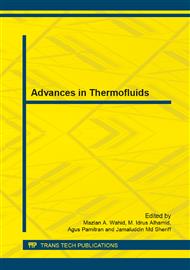[1]
Toms. B. A. Some observations on the flow of linear polymer solutions through straight tubes at large Reynolds numbers, International Congress on Rheology, Holland. 1948. Amsterdam. North I lolh. aid, 1949, Part 11, pp.135-141.
Google Scholar
[2]
F. -C. Li, Y. Kawaguchi, K. Hishida, and M. Oshima, Investigation of turbulent structures in a drag-reduced turbulent channel flow with surfactant additive by stereoscopic particle image velocimetry, Experiments in Fluids, vol. 40, no. 2, pp.218-230, (2006).
DOI: 10.1007/s00348-005-0061-1
Google Scholar
[3]
H. W. Bewersdorff, Rheology of drag reducing surfactant solutions, in Proceedings of the ASME Fluids Engineering Division Summer Meeting (FED'96), vol. 237, pp.25-29, San Diego, California, USA, (1996).
Google Scholar
[4]
Yanuar and Watanabe K. Tom's effect of guar gum additive for crude oil in flow through square ducts. The 14thInternational symposium on transport phenomena. Bali Indonesia. Elsevier 2004. P. 599 – 603.
Google Scholar
[5]
Yanuar, Gunawan and M. Baqi, Characteristics of Drag Reduction by Guar Gum in Spiral Pipes, Journal Teknologi. Vol. 58 2012, p.95–99.
DOI: 10.11113/jt.v58.1556
Google Scholar
[6]
Satoshi Ogata, Tetsuya Numakawa and Takuya Kubo. Drag reduction of bacterial cellulose suspensions. Advanced in Mechanical Engineering. 2011. Pp 1-6.
DOI: 10.1155/2011/528373
Google Scholar
[7]
P.S. Virk and R.H. Chen, Type B drag reduction by aqueous and saline solutions of two biopolymers at high Reynolds number", in Preceedings of the 2nd International Symposium on Seawater Drag Reduction, pp.545-558, Busan, Korea, May (2005).
Google Scholar
[8]
A.A. Robertson and S.G. Mason, The characteristics of dilute fiber suspensions, TAPPI, vol. 40, pp.326-334, (1957).
Google Scholar
[9]
W. Mih and J. Parker, Velocity profile measurements and phenomenological description of turbulent fiber suspension pipe flow, TAPPI, vol. 50, pp.237-246, (1967).
Google Scholar
[10]
Yanuar and Watanabe K. Drag Reduction of Guar Gum in Crude oil,. The 13th International Symposium on Trannsport Phenomena. Victoria Canada. Elsevier 2002. P. 833 – 836.
Google Scholar
[11]
Yanuar, et al. Hydraulics conveyances of mud slurry by a spiral pipe, Journal of Mechanical Science and Technology 23 (2009) 1835 – 1839. Springer.
DOI: 10.1007/s12206-009-0611-1
Google Scholar


